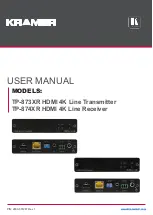
V A L A V I O N I C S L T D
C O M 2 0 0 0 – V H F T R A N S C E I V E R
I N S T A L L A T I O N A N D O P E R A T O R ’ S M A N U A L
Revision 3
Page 9 of 31
March 2013
2.3.3
Wire Harness Fabrication
Val Avionics Ltd. Strongly recommends the use of a factory fabricated wire harness (VPN 751027) with your new
COM 2000 –
VHF Transceiver
. Use of the factory fabricated wire harness will ensure proper operation of the COM
2000, reduction in the occurrence of interfering signals and ground loops, greatly reduced installation time, and
provide prolonged trouble-free performance of your new equipment.
Although strongly recommended, it is not required to use the factory fabricated wire harness when installing the
COM 2000. A wiring harness can be fabricated in the field. Refer to appendix B of this manual for a complete
wiring diagram. The COM 2000 is connected to the aircrafts avionics bus via a 5 AMP circuit breaker. All wires
must be 22 AWG MIL-SPEC, unless otherwise noted in accordance with current regulations. Two and three
conductor shielded MIL-C-27500 or equivalent wire must be used where indicated. Use AMP Contact Crimping
Tool (AMP P/N 601966-1) with Positioning Tool (AMP P/N 601699-5) or equivalent to ensure good quality
contacts. Refer to FAA Advisory Circular AC 43.13-2A for acceptable practices and techniques.
2.3.4
COM 2000 Installation
2.3.4.1
Mounting
The COM 2000 is rigidly mounted in the aircrafts avionics stack. Once a location has been selected, a visual
inspection should be made of the area directly behind the panel which, will be occupied by the COM 2000 and
harness assembly for obvious obstructions such as heater ducts, control cables, fuel and oil lines or any other
obstruction. Pay particular attention to the control yoke assembly. It should be moved to the full limit of travel and
verified that sufficient clearance exists prior to beginning installation. Most aircraft instrument panels will already
have existing radio mounting cutouts. If the location you have selected requires that a mounting hole be cut, refer to
Figure 4: Panel Cut Out on Page 16 for the mounting template. Mark and cut the mounting holes as required.
Position the unit’s mounting tray in its upright position, and from the rear of the panel. With the unit held in place,
insert the two of the supplied 6-32 X 3/8” screws from the front and tighten as appropriate. The installing agency
must fabricate and attach rear support brackets to the aircraft structure behind instrument panel as appropriate to
support the rear of the COM 2000.
Then, attach these brackets to the provided attachment points on the rear of the
unit with the supplied 6-32 1/4" Screws.
2.3.4.2
Antennas
One antenna is required for the COM 2000 installation. A standard COM antenna can be used with the unit such as a
COMANT CI-121 or equivalent. Follow the antenna manufacture’s installation Manual to ensure proper installation
of the antenna.
2.3.4.3
Audio
The COM 2000 has two auxiliary audio inputs and two audio outputs, Speaker audio and Headset audio. In
installations with two radio and/or more audio devices, it is strongly recommended that these audios be coupled to a
quality audio selector panel such as a Val Avionics AP 100. For complete details, refer to the interconnect wiring
diagrams in Appendix B.
2.4
POST INSTALLATION CHECK










































